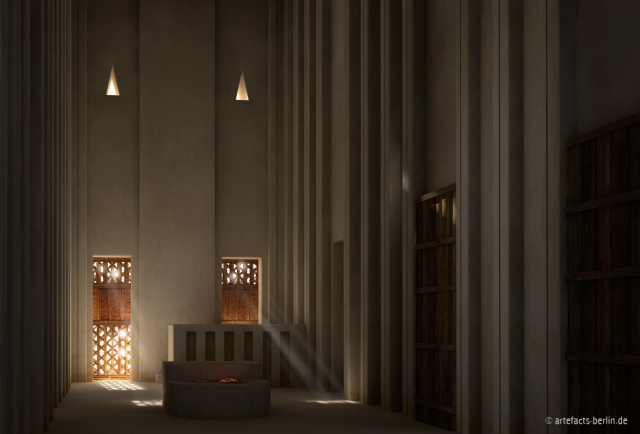Films: Ancient Near East Architecture
Visualise the Ancient Near East with 3d Models

Early Mesopotamia, Ur III, Babylon & Egypt
To accompany our podcast series on the Ancient Near East we have put together some films to help you visualise the buildings and cities of this period of Mesopotamian, Egyptian and Assyrian history.
All the beautiful 3d models below were created by Artefacts, a conceptual design agency who specialise in the visualisation of archaeological and scientific content, and have featured in a large exhibition about Uruk, called ‘Uruk: 5000 years of the megacity’, in the Pergamon Museum in Berlin, and subsequently at the LWL-Museum für Archäologie, Herne, in 2013/14.
All the material below is only a proposal of a reconstruction and is copyrighted © artefacts-berlin.de.
Early Mesopotamia and the Uruk period.
1. Anu Ziggurat and the White Temple of Uruk, 4th millennium BCE - film produced in 2012.
This short video shows a circular, looped animation around the Anu Ziggurat of Uruk of the 4th millennium BCE, the so-called Late Uruk Period. On top of the Ziggurat, the White Temple is situated. The reconstruction is based upon a temple model found within the ruins.
Anu Ziggurat and the White Temple of Uruk, 4th millennium BCE from Artefacts on Vimeo.
2. Uruk: The Late Uruk Period - film produced in 2011.
Excavations in the centre of Uruk uncovered a large variety of monumental buildings with often unparalleled architectural features. This animation shows the complex centre of the Late Uruk Period. Due to the poor state of preservation of most buildings, and the uniqueness of this early architecture, the reconstruction was challenging and ambitious, as it had never previously been attempted to this extent.
The video was made as a visual aid during the exhibition "Uruk - 5.000 years of the megacity".
Uruk: The Late Uruk Period from Artefacts on Vimeo.
3. (Re-)Constructing the Stone-Cone Building - film produced in 2013.
Together with Prof. Dr. Eichmann, who has been studying the “Stone-Cone Building” for many years, Artefacts reconstructed the building process on the basis of the archaeological evidence. The results were visualised in an animation showing the building's entire construction process, from its complex foundation design to reflections about its inner installations. Each step of the building process is shown in detail in order to give an informative overview of the construction of this outstanding building.
The video explains the construction of the Stone-Cone building in over four minutes.
(Re-)Constructing the Stone-Cone building in Uruk - Exhibition Version from Artefacts on Vimeo.
The Ur III Period
1. The Eanna Ziggurat of the 21st century BCE - film produced in 2012.
Uruk/Warka, situated in modern-day Iraq, is one of the first cities in the world and was populated almost without interruption for over 5,000 years – from the 4th millennium BCE to the 1st millennium CE. In the so called 3rd dynasty of Ur (21st century BCE), the centre of Uruk was dominated by a ziggurat, that was dedicated to the goddess Inanna.
This short video shows two types of reconstruction. The first is a purely technical one, where only the most secure information was used to rebuilt the Eanna sanctuary. The second is a life-like momentum: it shows the loose reconstruction of a religious ceremony.
Uruk: The Eanna Ziggurat of the 21st century BCE from Artefacts on Vimeo.
Old Babylonian Period
1. The palace of Sin-kashid - film produced in 2013.
In the Old-Babylonian Period, Sin-kashid founded his dynasty and built his palace in the western part of the city around the mid-19th century BCE.
The animation shows the different areas and offers an insight into the palace economy and the everyday life. Small-finds that were found in the palace and texts that refer to the palace were included in our animation. Every detail was researched to create a reconstruction that gives an insight into the world of Old Mesopotamia.
Uruk: The palace of Sin-kashid from Artefacts on Vimeo.
19th Dynasty Egypt
1. The reconstruction of Pi-Ramesse - this film was produced in 2016.
Qantir/Pi-Ramesse (House of Ramses) is situated in the Nile-Delta of Egypt, about 120 km northeast of Cairo. The city was founded by Ramesses II. in the 13th century BCE and was since then his main residence. It is structured by monumental palace and temple buildings and was the seat of the royal cariotry.
Supported by the Badisches Landesmuseum Karlsruhe, the Roemer- und Pelizaeus-Museum Hildesheim and the excavation project itself, a nearly 7-minute animation and several still images could be created during a time-span of nine months. Especially the visualisation of the horse stables was of upmost importance, as these were excavated quiet well. Besides that, the urban structure of the city was visualised very carefully.

